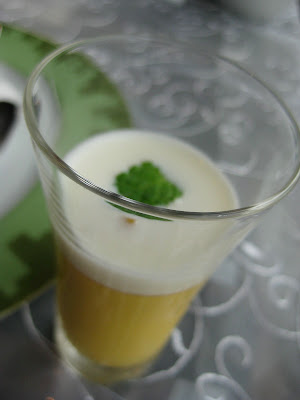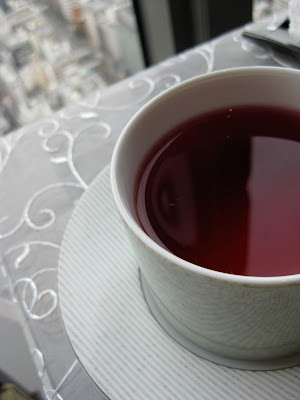Tokyo a la Carte
Tokyo food guide, Tokyo restaurant guide, Tokyo cooking guide. One bite at a time.
Thursday, March 10, 2016
Wednesday, January 21, 2009
High Tea at the Mandarin Oriental

It's official. I love tea at Mandarin Oriental.
I'm going to let the photos fend for the culinary reasons, but, you know what, afternoon tea is not so much about the food but the experience. You're there to soak up a little peace of mind, bask in the moments that leisurely pass by, and be treated like... well, like a guest at a five star hotel! And that brings me back to... one of the reasons I liked the hotel right away (other than the fact that it is a five star. I know, so hard to like.) was that it was very Tokyo. It is located in Nihonbashi--the center of the city--but its presence is not obvious from the street as it occupies the top floors of a business tower. The entrance is not bold, either, but the details let you know your pampering has begun. As you walk past the front desk and wait for the elevator to take up upstairs, you may notice the faint fragrance of luxury--did you know that hotels have signature scents?

Oh, High Tea at the Mandarin Oriental, let me count the ways...



Pictured is a chocolate scone, there was also plain.


But just look at how they were served...


These are definitely two of the best seats in the house.
Ask for the seats by the window to make your visit even more breathtaking.
High tea? 4,000 yen.
Feeling Five Star? Priceless.
Go.
Thursday, March 27, 2008
地鳥大根うどん
Wow--gorgeous in looks and taste. The chicken was meaty, juicy and melt-in-your mouth good. The two daikon pieces were huge, which is great, but soft from being steeped in broth and seasonings for pobably an hour or so. There was even a large carrot which had also been pre-cooked and was just as good. Gorgeous orange color.
The broth and udon were less impressive. But I am biased.
Tuesday, February 26, 2008
Unexpected Coffee Break 2
On Sunday the haru-ichiban winds were out of control. (Haru-ichiban are very strong, slightly warm gusts of wind said to be the start of spring. Think: Mary Poppins.) They stopped traffic, literally, halting and delaying JR trains all across Tokyo. Of course, as God (or Murphy or Christophe) would only have it, Ninapod and I were scheduled to arrive for luncheon (that was on purpose--a mere lunch? No, this was a *luncheon*) at a long-time family friend and former neighbor's house about an hour away. In fact, this was even a rescheduled luncheon from two weeks prior when a (get this) a snowstorm (in how many years in Tokyo??) intercepted our gathering, icing the roads and even making sure Nina caught a cold.
The journey one-way took just over two hours. As I waited for a train to get ready I ducked into an adjacent Doutour cafe and ordered a matcha latte, my recent drink of choice. The verdict: It is better than Starbucks'. I like lattes scalding hot and this was unexpectedly so, without me asking the barista for it to be. The matcha syrup was not too sweet and the dollop of cream and sprinkle of real matcha powder on top was fun. It was the perfect coffee break for a windy day when everything is unexpected.
Photo: As I waited in line I noticed little bags of dried fruit selling for a few hundred yen.
Friday, February 22, 2008
Power Shortage and an Unexpected Coffee Break
Just as I was tranfering train lines at Iidabashi today, a man's voice announced the electricity had gone out on the trains. Luckily it was a mere 5-10 minutes until the power came back, but unsure of how long I'd be standing waiting and since I was not rushing anywhere I took refuge at a small Starbucks within the station.
I had an iced coffee and a small-ish sandwich, one half filled with a crunchy (cucumber?) potato salad, and the other a slighty soggy-ed shrimp and tomato combination. As is usually the case in Japanese sandwiches, the bread was nothing special.
I always enjoy coffee breaks, all the more if they are unexpected. And I'm also always surprised at how unimpressive food is at Starbucks in Japan, especially considering the plethora of good food available on almost any budget level everywhere else in Japan (except sandwich bread). What's up??
Tuesday, January 29, 2008
Din Tai Fung
What is Din Tai Fung? It's where they serve the most delicious shoronpo in the world. The store made its international debut over 10 years ago, unveiling its flagship store within Shinjuku Takashimaya. What was then a small eatery tucked between a gift shop selling soap, and some kitchenware pots has since expanded to dozens of stores across Japan, China and the US.
Amazingly, a 30 minute wait is still considered relatively short at many of these locations today. The little steamed sacs of juicy minced pork are full of clear, rich broth ; Place a few thin strands of flavored shredded ginger on top and... Well. That's a sure way to woo me, and girlfrien' I'm not even tryii' to sound Chinese (snap snap).
First-timers, fret not. Although eating these delicate morsels of BLISS might sound complicated (soup? pork sacs? I don't get it), there is a friendly laminated illustrated guide that explains these steps on each table.
➀ Pour soy sauce vinegar (they already mixed them up for you) onto your small dish of ginger strips.
➁ As soon as steaming hot shoronpo are brought to you, gently pick one up by the pinched area of skin on top (where the dough overlaps), and crate it over to your ceramic spoon. Note: The skin of these dumplings is very thin, so if you are too rough or let the dumpling cool, it will stick to the bottom of the steamer and rip, spilling the precious, precious soup.
➂ By now you will notice that I am completely not following The Friendly Laminated Guide For How To Eat Shoronpo, but who gives, my way is just as good. Once the dumpling is safely nestled into its mini-tub, take a few strands of ginger placing it on top of the shoronpo. Just the right amount of soy sauce and vinegar will trickle down into its folds and crevices. Immediately break the skin on the lower side (where it's thinnest) and let the precious (precious) soup flood into your spoon. Wait a split second to cool to slightly less than scalding and sip longingly. **BLISS**. Note: Shoronpo has a very short life span. For most of its life it's either too hot or too cool, with the exception of an approximate 14.7 second interval where it is immaculate. But that's all you get, 14.7 seconds.
➃ After you've drank the soup, tip the deflated shoronpo into your mouth--ginger and everything--in one bite. Savor. Repeat. This is no time to be dainty or polite, as your friends will be vultures as soon as they realize how good these dumplings are.
Two other dishes that are must-haves here are the hot and sour soup "san raa tan", and the chinese noodles topped with deep fried pork cutlets called "pai kō men".
I used to be a hot and sour soup fiend. Now I am a paiko men DEMON. It is so good. Just look at how beautiful it is!
This is one restaurant where you can eat to your heart's content and just barely top ¥5,000 for two. That's including a drink or two. To quote a South Park character that I saw while on vacation over the holidays: Nicccccceeee.
Til next
小龍包 steamed pork dumplings
酸辣湯 hot and sour soup
パイコー麺 Chinese noodles with fried pork cutlet
Din Tai Fung 鼎泰豊
5-24-2 Sendagaya, Shibuya-ku Tokyo 151-8580
(12F, Shinjuku Takashimaya Department Store)
T/ 03-5361-1381
www.dintaifung.com.tw/en/index.asp
Tuesday, October 16, 2007
Renkon Mentai
I love lotus root. They're crisp like autumn apples when chopped, and hearty like tororo (grated naga imo, or yam) when grated. Renkon (or lotus root) has a wonderful texture either way, and due to the lack of strong flavor it works well with many different ingredients. I like to chop it up in bite-size pieces and toss it with a rich mentaiko (spicy cod roe) sauce. This is an easy side dish and is great cold, making it an ideal make-ahead-and-let-sit-in-fridge-til-dinner/potluck dish.
Lotus root will start changing color if you let it sit out for too long, ruining the presentation of its almost porcelain-like appearance. So before you start chopping the holey root, let it sit in a mixture of vinegar and water for about 5 to 10 minutes. You should peel the skin with a peeler first.
While it's soaking, prepare the sauce. Scrape the roe from one large or two medium-sized mentaiko sacs. You should make a a long insertion length-wise, spread the two halves so the skin is touching the cutting board, and scrape out the roe with the dull end of a knife, or a spoon. If you are gentle you will not break the membrane. For some reason, I find a squeeze of lemon juice on the mentaiko aids in smooth scraping of the roe.
After you have enough mentaiko (and "enough" depends on how much you like these little eggs!), mix it with the same amount or less of mayonnaise (this, too, depends on how much you like mayonnaise; less mayo and more mentaiko is the way I like it). The mentaiko is salty enough so you won't need any salt for taste.
Let the sauce sit and return to the soaking lotus root. Cut them in bite size pieces, even thin slices. Boil a large pot of water and carefully dump the chopped roots into the boiling water. Let boil for about 3-5 minutes (even less if you've sliced the roots)--that's it! You don't want to lose the delicious crunch of these vegetables by cooking them too long. Taste one after a few minutes and when you feel they need another minute, that's when you should take them out. Because you will...
Use a strainer and allow the roots to cool naturally--do not cool them with water. Right after you have strained them, squeeze half a lemon (or more, if you like lemon! I'm really roundabout with my measurements, aren't I??) to slow down the color-changing process. They might get a bit purple-ish where the lemon has not touched. Although they are "cooling", since they are still hot they will continue to cook slightly. This is fine.
After maybe about 5 to 10 minutes, when they are still warm to hot to the touch, toss them with the mentaiko mixture. You should do this while the renkon are still warm so the mayonnaise kind of melts and sticks to the root.
To garnish, use chopped green onions and toasted sesame seeds. You might want to wait to put them on until they are ready to be served.
This is a delicious dish and makes such a beautiful presentation that it will surely be a hit at any dinner table or party! Try it!
レンコン明太 renkon mentai
とろろ grated yam
長いも naga imo
レンコン lotus root
明太子 spicy cod roe
I think I see Tim Burton in there...



